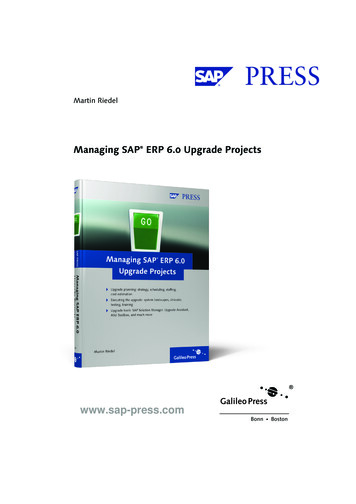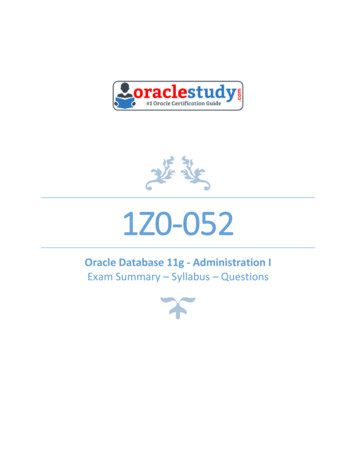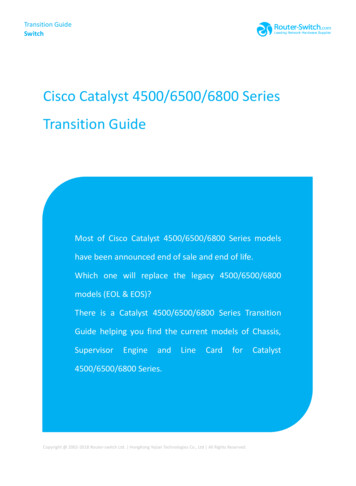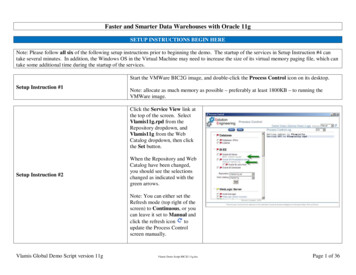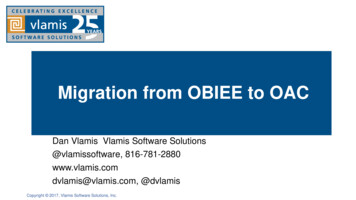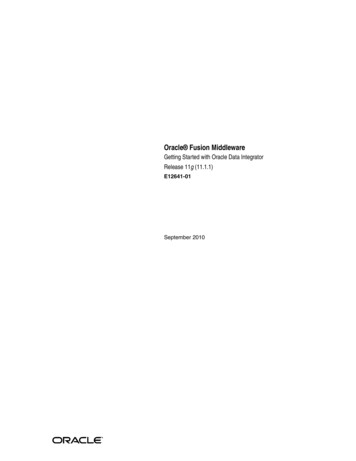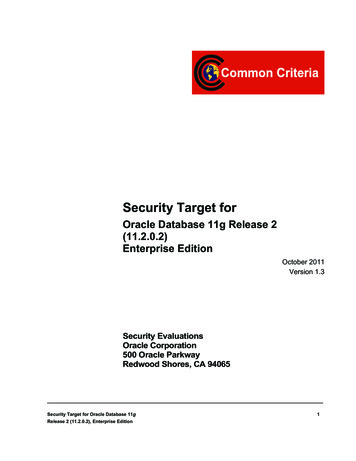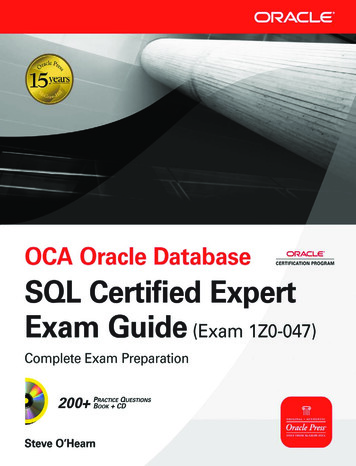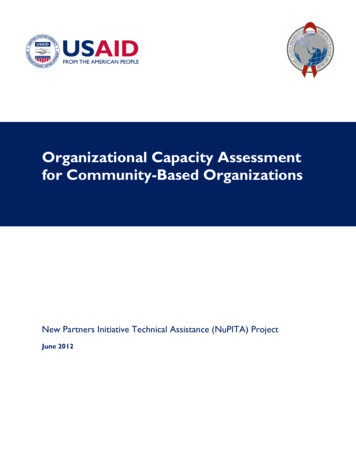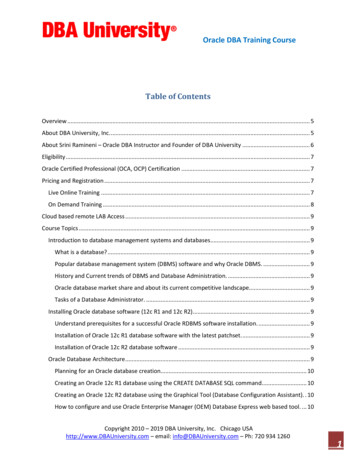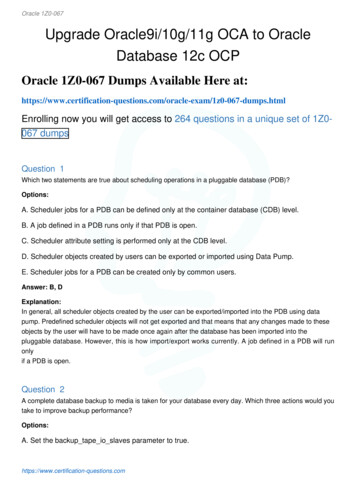
Transcription
Oracle 1Z0-067Upgrade Oracle9i/10g/11g OCA to OracleDatabase 12c OCPOracle 1Z0-067 Dumps Available Here exam/1z0-067-dumps.htmlEnrolling now you will get access to 264 questions in a unique set of 1Z0067 dumpsQuestion 1Which two statements are true about scheduling operations in a pluggable database (PDB)?Options:A. Scheduler jobs for a PDB can be defined only at the container database (CDB) level.B. A job defined in a PDB runs only if that PDB is open.C. Scheduler attribute setting is performed only at the CDB level.D. Scheduler objects created by users can be exported or imported using Data Pump.E. Scheduler jobs for a PDB can be created only by common users.Answer: B, DExplanation:In general, all scheduler objects created by the user can be exported/imported into the PDB using datapump. Predefined scheduler objects will not get exported and that means that any changes made to theseobjects by the user will have to be made once again after the database has been imported into thepluggable database. However, this is how import/export works currently. A job defined in a PDB will runonlyif a PDB is open.Question 2A complete database backup to media is taken for your database every day. Which three actions would youtake to improve backup performance?Options:A. Set the backup tape io slaves parameter to true.https://www.certification-questions.com
Oracle 1Z0-067B. Set the dbwr io slaves parameter to a nonzero value if synchronous I/O is in use.C. Configure large pool if not already done.D. Remove the rate parameter, if specified, in the allocate channel command.E. Always use RMAN compression for tape backups rather than the compression provided bymediamanager.F. Always use synchronous I/O for the database.Answer: B, C, DExplanation:Tuning RMAN Backup Performance: Procedure Many factors can affect backup performance. Often,finding the solution to a slow backup is a process of trial and error. To get the best performance for abackup, follow the suggested steps in this section: Step 1: Remove RATE Parameters from Configured andAllocated Channels Step 2: If You Use Synchronous Disk I/O, Set DBWR IO SLAVES Step 3: If You Failto Allocate Shared Memory, Set LARGE POOL SIZE Step 4: Tune RMAN Tape Streaming PerformanceBottlenecks Step 5: Query V Views to Identify ase/121/BRADV/rcmtunin.htm#BRADV172Question 3For which three pieces of information can you use the RMAN list command?Options:A. stored scripts in the recovery catalogB. available archived redo log filesC. backup sets and image copies that are obsoleteD. backups of tablespacesE. backups that are marked obsolete according to the current retention policyAnswer: A, B, DExplanation:Explanation: About the LIST Command: The primary purpose of the LIST command is to list backup andcopies. For example, you can list: -Backups and proxy copies of a database, tablespace, datafile, archivedredo log, or control file -Backups that have expired -Backups restricted by time, path name, device type,tag, or recoverability -Archived redo log files and disk copiesReference:http://docs.oracle.com/cd/B28359 on 4https://www.certification-questions.com
Oracle 1Z0-067Which three statements are true about a job chain?Options:A. It can contain a nested chain of jobs.B. It can be used to implement dependency-based scheduling.C. It cannot invoke the same program or nested chain in multiple steps in the chain.D. It cannot have more than one dependency.E. It can be executed using event-based or time-based schedules.Answer: A, B, EExplanation:Chains are the means by which you can implement dependency based scheduling, in which jobs arestarteddepending on the outcomes of one or more previous jobs. DBMS SCHEDULER.DEFINE CHAIN STEPDBMS SCHEDULER.DEFINE CHAIN EVENT STEPReference: http://docs.oracle.com/cd/B28359 on 5Because of logical corruption of data in a table, you want to recover the table from an RMAN backup to aspecified point in time.Examine the steps to recover this table from an RMAN backup:1.Determine which backup contains the table that needs to be recovered.2.Issue the recover table RMAN command with an auxiliary destination defined and the point in timespecified.3.Import the Data Pump export dump file into the auxiliary instance.4.Create a Data Pump export dump file that contains the recovered table on a target database.Identify the required steps in the correct order.Options:A. 1, 4, 3B. 1, 2C. 1, 4, 3, 2D. 1, 2, 4Answer: DExplanation:Because according to oracle PDFs if you run restore table . auxiliary a impede and rename can beincluded. So there is no reason to make the import manually if it can be already included in step 2.Reference: .com
Oracle 1Z0-067Question 6Which two are prerequisites for setting up Flashback Data Archive?Options:A. Fast Recovery Area should be defined.B. Undo retention guarantee should be enabled.C. Supplemental logging should be enabled.D. Automatic Undo Management should be enabled.E. All users using Flashback Data Archive should have unlimited quota on the Flashback DataArchivetablespace.F. The tablespace in which the Flashback Data Archive is created should have AutomaticSegment SpaceManagement (ASSM) enabled.Answer: D, FExplanation:There are a number of restrictions for flashback archives: The tablespaces used for a flashback archivemust use local extent management and automatic segment space management. The database must useautomatic undo management.Reference:http://www.dba-oracle.com/t 11g new enabling fdba.htmQuestion 7The environmental variable oracle Base is set to /u01/app/oracle and oracle home is set to /u01/app/oracle/product/12.1.0/db 1.You want to check the diagnostic files created as part of the Automatic Diagnostic Repository (ADR).Examine the initialization parameters set in your database.NAME TYPE VALUE-------------------------------------------- ------------------- it file round dump deststringcore dump deststringdb create file deststringdb recovery file deststring/u01/app/oracle/fast recovery areadiagnostic deststringWhat is the location of the ADR base?https://www.certification-questions.com
Oracle 1Z0-067Options:A. It is set to/u01/app/oracle/product:/12.1.0/db 1/log.B. It is set to /u01/app/oracle/admin/en12.1.0/adump.C. It is set to /u01/app/oracle.D. It is set to /u01/app/oracle/flash recovery area.Answer: CExplanation:The Automatic Diagnostic Repository (ADR) is a directory structure that is stored outside of the database. Itis therefore available for problem diagnosis when the database is down.The ADR root directory is known as ADR base. Its location is set by the DIAGNOSTIC DEST initializationparameter. If this parameter is omitted or left null, the database sets DIAGNOSTIC DEST upon startup asfollows:If environment variable ORACLE BASE is set, DIAGNOSTIC DEST is set to the directory designated byORACLE BASE.If environment variable ORACLE BASE is not set, DIAGNOSTIC DEST is set to ORACLE 9 n 8You want to export the pluggable database (PDB) hr pdb1 from the multitenant container database (CDB)CDB1 and import it into the cdb2 CDB as the emp pdb1 PDB.Examine the list of possible steps required to perform the task:1.Create a PDB named emp pdb1.2.Export the hr pdb1 PDB by using the full clause.3.Open the emp pdb1 PDB.4.Mount the emp pdb1 PDB.5.Synchronize the emp pdb1 PDB in restricted mode.6.Copy the dump file to the Data Pump directory.7.Create a Data Pump directory in the emp pdb1 PDB.8.Import data into emp pdb1 with the full and remap clauses.9.Create the same tablespaces in emp pdb1 as in hr pdb1 for new local user objects.Identify the required steps in the correct order.Options:A. 2, 1, 3, 7, 6, and 8B. 2, 1, 4, 5, 3, 7, 6, 9, and 8C. 2, 1, 3, 7, 6, 9, and 8D. 2, 1, 3, 5, 7, 6, and 8https://www.certification-questions.com
Oracle 1Z0-067Answer: CExplanation:Because the step 2 says that you perfom an expdp with the full clause and you don’t need to create thetablespaces when you perform the impdp. FULL yes will export tablespace definitions. So no need step 9.Reference:https://docs.oracle.com/cd/B10501 01/server.920/a96652/ch01.htmQuestion 9You notice performance degradation in your production Oracle 12c database. You want to know whatcaused this performance difference.Which method or feature should you use?Options:A. Database ReplayB. Automatic Database Diagnostic Monitor (ADDM) Compare Period reportC. Active Session History (ASH) reportD. SQL Performance AnalyzerAnswer: BExplanation:References: http://docs.oracle.com/cd/E24628 01/server.121/e17635/tdppt degrade.htmQuestion 10Examine the command:SQL RECOVER DATABASE USING BACKUP CONTROLFILE UNTIL CANCEL;In which two scenarios is this command required?Options:A. The current online redo log file is missing.B. A data file belonging to a noncritical tablespace is missing.C. All the control files are missing.D. The control file backup is older than the control file backup.E. All the data files are missing.Answer: A, uestions.com
Oracle celWould you like to see more? Don't miss our 1Z0-067 PDFfile tions.com
The environmental variable oracle_Base is set to /u01/app/oracle and oracle_home is set to /u01/app/ oracle/product/12.1.0/db 1. You want to check the diagnostic files crea
